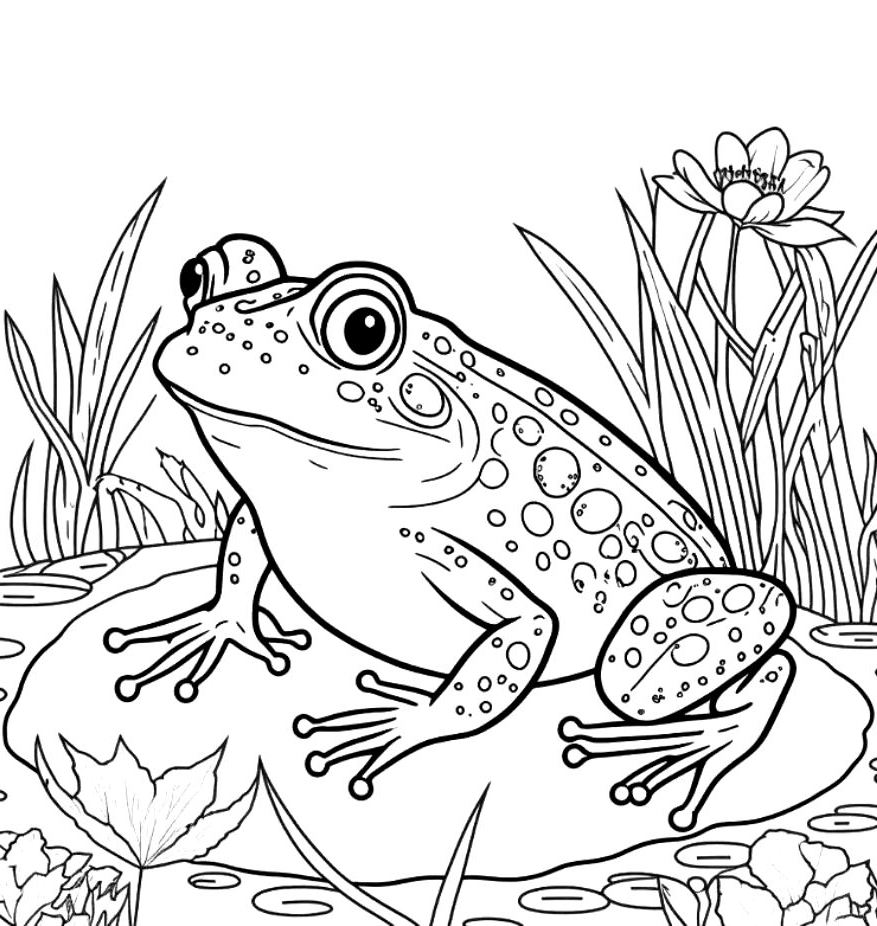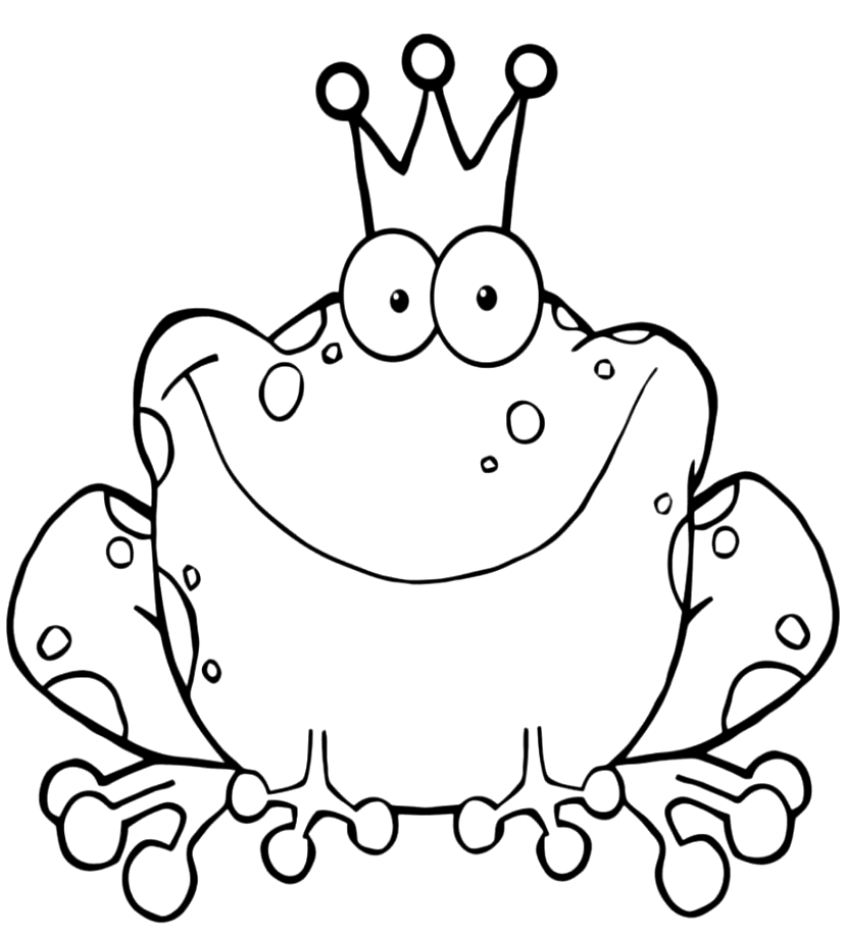Frogs
We will have fun and learn with frog coloring pages. Frogs are interesting green creatures that live near the water. When choosing a frog coloring page, it will be enough to pay attention to the level of convenience. We will need some colored pencils while working with these pages. These colors are; primary colors such as green, yellow and brown.
Free Frogs coloring pages (printable sheets)
Hope you enjoy our frog pages. Now we will move on to a little more detailed information. They are also known as tailless frogs. Likewise, tailed frogs are also called salamanders. It is a genus of carnivorous amphibians, which can be found in various sizes, have strong legs, their tongues are attached to the front of the mouth, and almost all members are carnivorous. While it can be seen in feeding with plants during the larval stage, there are also omnivorous species. They have a semi-aquatic life and undergo metamorphosis from juvenile to adulthood. Juveniles have a tail, but towards adulthood the tail degenerates, becomes shorter, and eventually disappears. Members of 2 species of the genus Ascaphus, which are shown as an exception to this situation, do not actually have a tail. Although the small protrusion on the back of the male members is thought to be the tail, it is actually an extension of the cloaca.
Frog Species
- There are seventeen species collected in six families: Bombinatoridae, Pelodytidae, Pelobatidae, Hylidae, Ranidae, Bufonidae. Some of these types are listed as follows:
- rufous frog (Bombina bombina)
- Caucasian frog (Pelodytes caucasicus)
- Earth frog (Pelobates syriacus)
- Caucasian warty frog (Bufo verrucosissimus)
- Warty frog (Bufo bufo)
It is expressed as
What Are the Characteristics of Frog Species?
Pipa Pipas, also known as the Skirted Frog, generally known as Surinamese frogs, have a very flat body and can be kept as pets in the aquarium. This species, which lacks a tongue and teeth, has long hands and feet. The most interesting feature of another species, the glass frog, is that many internal organs such as the heart or liver can be seen due to the transparent underside of its skin.
Twelve different species of glass frogs have been found so far, which live in regions suitable for this situation because they have to keep their skin constantly moist. Looking at the Vietnamese moss frog; Vietnamese moss frogs, which usually live in the tropical forests of the northern part of Vietnam, get their name from their moss-like appearance.
In case of approaching predators, it pulls its legs inwards and resembles a moss and can be camouflaged in this way. It is also commonly fed at home in Asia. Another variety is the tortoise frog. The first specimens of this frog species, which have an appearance resembling a shellless turtle with its pink body and small head, were found in the western part of Australia. Because they complete their development entirely inside the egg, the size of their eggs is much larger than the eggs of all other frog species in Australia.
What Are the Characteristics of Frogs?
- Frogs have many characteristics. Some of these features are listed as follows:
- Frogs can easily live both in the middle and in the water.
- Frogs undergo metamorphosis, in other words.
- The larvae of frogs breathe through gills. Adults perform skin and lung respiration.
- The skin of frogs is always moist. They have glands that can secrete mucus.
- Frogs have four legs and also five toes. Fingers have a nail-free structure.
- Frog hearts have three chambers. Double circulation occurs.
- Body temperatures are highly variable. They are cold blooded animals.
- External fertilization is seen in frogs. They reproduce with eggs.
- They have closed circulation.
- Excretory substances are urea.
As an example of the most well-known frogs today; water frog, toad and salamander can be given.
Where Do Frogs Come From?
Frogs can live mainly in any ocean except Antarctica. The most interesting species are found in tropical regions. Most of the frogs are found in warm countries, in the water or near water such as rivers and streams.
Do Frogs Have Ears?
Within the scope of a recent study, it has been shown that living things that do not have an eardrum and middle ear can perceive sounds. Just like mammals, frog species that do not have ears have eardrums directly on their skin. They can hear through the cartilage structure.
What Do Frogs Eat?
Frogs generally prey on insects, worms, small mollusks, small fish or spiders in moist and wet areas such as rivers, swamps, and ponds. Small frog larvae continue their lives by feeding on dead animal scraps.
Ecological Distribution and Habitat
This very diverse team is scattered almost all over the world. While they generally prefer moist environments to protect their moist bodies, some species have adapted to dry environments thanks to specific adaptations. They live in many places such as lakes, streams, wetlands, rainforests, swamps, sand dunes.
Behavior and Ethology
During mating, they exhibit "hug behavior" called amplexus. In this way, the male gets on the female's back and fertilizes an egg that is laid. There are also types of hugging behavior. For example, it can be from the axilla, that is, from the armpit, or from the inguinal, that is, from the groin. They can wander this way for days during the amplexus.
Each frog's call (croak) is unique to its species. Frogs create air by passing it through the larynx. In most croaking frogs the sound is amplified by one or more vocal sacs, skin membranes under the throat or at the corner of the mouth, which differ during the growth of the croak. Some frog calls are so loud that they can be heard from 1.5 km away.
The croaking behavior is often exhibited by males during the mating season to find a partner. In some species, males show this behavior alone, while in some species, males gather and show a choral behavior. In certain species, females may respond to males to reinforce their calls. They prefer men with more intense voices, who stand out in the crowd during choral behavior. Many species also have special calls to drive other males out of their territory. All calls are produced with the frog's mouth closed, but in some species there is also an emergency call produced with its mouth open in case of danger. This call is different from other calls, and usually when the frog is caught, it uses this method to distract the hunter and try to make him quit. The calls of the concave-eared flood frog (Amolops tormotus) are unusual in many ways. Males can produce calls that fall into the ultrasound frequency range when they communicate, thanks to the variety of calls in which up and down frequency modulations take place.
Most frog species lay their eggs directly in water or moist environments. It is also known that eggs are glued under leaves or hung on branches. Eggs can be laid in a cluster or they can be separate. Some species keep watch over the eggs, some lay eggs and leave, while some species carry their eggs on their backs. Since the death of the fry is high, many eggs are usually laid. It has been observed that Lithobates catesbeianus can lay 10,000-20,000 eggs at a time.
















